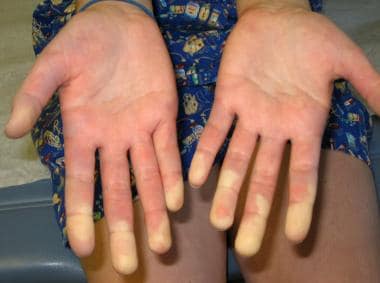Practice Essentials
Perhaps the best way to consider mixed connective tissue disease is as an undifferentiated connective tissue disease represented mostly by Raynaud phenomenon and anti-RNP antibody. See the image below.
Raynaud phenomenon showing demarcation of color difference.
This disorder may evolve into one of several major connective tissue diseases or to an overlap syndrome of the major connective tissue diseases. The evolution of this disease requires the physician to carefully assess and constantly reassess the patient in anticipation of change and to provide early intervention with appropriate medical therapy.
Signs and symptoms
The most frequent presentation of mixed connective tissue disease is a child with polyarthritis, general malaise, and Raynaud phenomenon.
Patients may present with the following:
Sclerodermatous skin (usually limited to fingers but can be more extensive)
Sausage-shaped fingers
Proximal muscle weakness
Rash (finger ulcers or pits, Gottren papules)
Vasculitic rashes (usually palpable purpuric rashes)
Dysphagia
Gastroesophageal reflux disease (GERD) symptoms
Fever
Rheumatoid nodules
Lymphadenopathy
Alopecia
Telangiectasia
Headache
See Presentation for more detail.
Diagnosis
Laboratory studies
Diagnostic laboratory studies include the following:
Antinuclear antibody
Anti–double-stranded DNA
Autoantibody panel, including antibodies against ribonucleoprotein (RNP), Smith, Ro(SSA), La(SSB), Scl-70, phospholipids, cardiolipin and histone, total hemolytic complement, C3, C4, quantitative immunoglobulins, and thyroid studies
Imaging studies
Initial imaging studies should include the following:
Chest radiography
Barium swallow
Echocardiography
Other tests
Other tests include the following:
Baseline pulmonary function tests, including diffusing capacity of lung for carbon monoxide
Nailfold capillaroscopy, particularly in patients who have more scleroderma features
See Workup for more detail.
Management
The most important tools in the treatment of pediatric mixed connective tissue disease include tailoring the medical regimen, promptly attending to disease flares, and performing careful and frequent clinical and laboratory evaluations to test for new disease manifestations.
See Treatment and Medication for more detail.

